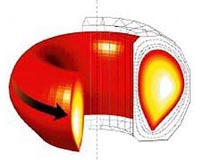 |
Toronto, Canada (SPX) Apr 18, 2011 Chlorine is an abundant and readily available halogen gas commonly associated with the sanitation of swimming pools and drinking water. Could a one-atom thick sheet of this element revolutionize the next generation of flat-panel displays and lighting technology? In the case of Organic Light-Emitting Diode (OLED) devices, it most certainly can. Primary researchers Michael G. Helander (PhD Candidate and Vanier Canada Graduate Scholar), Zhibin Wang (PhD Candidate), and led by Professor Zheng-Hong Lu of the Department of Materials Science and Engineering at the University of Toronto, have found a simple method of using chlorine to drastically reduce traditional OLED device complexity and dramatically improve its efficiency all at the same time. By engineering a one-atom thick sheet of chlorine onto the surface of an existing industry-standard electrode material (indium tin oxide, ITO) found in today's flat-panel displays, these researchers have created a medium that allows for efficient electrical transport while eliminating the need for several costly layers found in traditional OLED devices. "It turns out that it's remarkably easy to engineer this one-atom thick layer of chlorine onto the surface of ITO," says Helander. "We developed a UV light assisted process to achieve chlorination, which negates the need for chlorine gas, making the entire procedure safe and reliable." The team tested their green-emitting "Cl-OLED" against a conventional OLED and found that the efficiency was more than doubled at very high brightness. "OLEDs are known for their high-efficiency," says Helander. "However, the challenge in conventional OLEDs is that as you increase the brightness, the efficiency drops off rapidly." Using their chlorinated ITO, this team of advanced materials researchers found that they were able to prevent this drop off and achieve a record efficiency of 50% at 10,000 cd/m2 (a standard florescent light has a brightness of approximately 8,000 cd/m2), which is at least two times more efficient than the conventional OLED. "Our Cl-ITO eliminates the need for several stacked layers found in traditional OLEDs, reducing the number of manufacturing steps and equipment, which ultimately cuts down on the costs associated with setting up a production line," says Professor Zheng-Hong Lu. "This effectively lowers barriers for mass production and thereby accelerates the adoption of OLED devices into mainstream flat-panel displays and other lighting technologies."
Share This Article With Planet Earth
Related Links University of Toronto Faculty of Applied Science and Engineering Powering The World in the 21st Century at Energy-Daily.com
 Plasma Nanoscience Needed For Green Energy Revolution
Plasma Nanoscience Needed For Green Energy RevolutionSydney, Australia (SPX) Apr 15, 2011 A step change in research relating to plasma nanoscience is needed for the world to overcome the challenge of sufficient energy creation and storage, says a leading scientist from CSIRO Materials Science and Engineering and the University of Sydney, Australia. Professor Kostya (Ken) Ostrikov of the Plasma Nanoscience Centre Australia, CSIRO Materials Science and Engineering, has highlighte ... read more |
|
| The content herein, unless otherwise known to be public domain, are Copyright 1995-2010 - SpaceDaily. AFP and UPI Wire Stories are copyright Agence France-Presse and United Press International. ESA Portal Reports are copyright European Space Agency. All NASA sourced material is public domain. Additional copyrights may apply in whole or part to other bona fide parties. Advertising does not imply endorsement,agreement or approval of any opinions, statements or information provided by SpaceDaily on any Web page published or hosted by SpaceDaily. Privacy Statement |